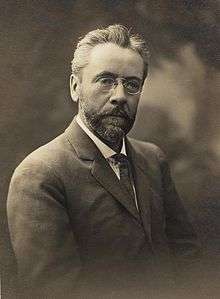Louis Eilshemius
Louis Michel Eilshemius (February 4, 1864 – December 29, 1941) was an American painter, primarily of landscapes and nudes. Although he was academically trained, much of his work has the unselfconscious character of naive art.
Louis Eilshemius | |
|---|---|
 | |
| Born | February 4, 1864 |
| Died | December 29, 1941 (aged 77) |
| Nationality | American |
| Known for | Painting |
Biography
Born into a wealthy family near Newark, New Jersey, Eilshemius was educated in Europe, after which he spent two years at Cornell University before beginning his art studies at the Art Students League of New York. He also studied privately with the American landscape painter Robert Crannell Minor (1839-1904).[1] He subsequently studied under Bouguereau at the Académie Julian in Paris and traveled widely in Europe, Africa and the South Seas, returning to the family brownstone in New York City where he was to live for the rest of his life.
His early landscapes, which show the influence of the Barbizon School and of Corot, George Inness and Albert Pinkham Ryder gained him little recognition from critics or the public. Around 1910, the element of fantasy in his work became more pronounced and his technique became coarser; henceforth, he often painted on cardboard instead of canvas.[2] As his works became more idiosyncratic, so did his behavior, and he developed an unsettling habit of visiting galleries and loudly condemning the works on display.[2]
His later, visionary works depicting moonlit landscapes populated with voluptuous nymphs caused his contemporaries particular consternation, due to their crudely rendered and often extravagantly smiling nudes. These are shown frolicking in forests or waterfalls, either alone or in groups, sometimes defying gravity by floating through the air. His paintings of New York rooftops are as lyrical as his pastoral scenes, and like them are often bounded by sinuous "frames" he painted onto his pictures.
Eilshemius also wrote verse and prose, composed music, painted, philosophized and became notorious for his numerous, often vitriolic, letters-to-the-editor of various New York City publications. His lack of public acclaim led him to desperate measures: suspecting that the length of his name was responsible for his neglect, in about 1890 he began signing his paintings "Elshemus"[3] (he reverted to the original spelling in 1913). On letterheads and in hyperbolic, self-published flyers he would proclaim his accomplishments: "Educator, Ex-actor, Amateur All-around Doctor, Mesmerist-Prophet and Mystic, Reader of Hands and Faces, Linguist of 5 languages", as well as world-class athlete and marksman, "Spirit-Painter Supreme", and musician whose improvisations rivaled the compositions of Chopin. All of this only reinforced the impression, already suggested by the peculiar imagery in many of his paintings, that he was either mad or a charlatan.
He was not without supporters, however. Eilshemius was championed by Marcel Duchamp, who "discovered" Eilshemius in 1917 and invited him to exhibit with him in Paris that year. Joseph Stella was an admirer and drew a particularly fine silverpoint portrait of him. His work was generally well received by French viewers and critics; his admirers included Matisse. Duchamp subsequently helped to arrange Eilshemius's first solo exhibition in 1920, at the Société Anonyme in New York City. The hostile critical reception to this exhibition, however, finally drove him to give up painting entirely in 1921, although there is a single known painting dated 1937. The remainder of his life was dedicated to self-promotion, and in 1931 he took to referring to himself as "Mahatma."[2] Victor Ganz started collecting art in his teenage years with the purchases of watercolors by Louis Eilshemius and Jules Pascin and an oil painting by Raphael Soyer.
Injured in an automobile accident in 1932, he became increasingly reclusive. His health in decline and his family fortune spent, he died in 1941.
Since his death, Eilshemius's work has found a wider audience. One of the artist's few consistent patrons, Roy Neuberger, donated a large body of Eilshemius' work to the Neuberger Museum of Art located at SUNY Purchase College in New York State.
According to Stefan Banz, there is no evidence that Eilshemius was a grandson of Swiss painter Louis Léopold Robert as some sources report.[4][5]
Notes
- Karlstrom, Paul. "Eilshemius, Louis M(ichel)". Grove Art Online. Retrieved January 4, 2014.
- Karlstrom, 1978, p. 96.
- Schack, 1939, p. 51.
- Banz, Stefan, 2015, "Louis Michel Eilshemius - Peer of Poet Painters", KMD - Kunsthalle Marcel Duchamp, The Forestay Museum of Art, JRP|Ringier, p. 515.
- "Hesse, Wolfgang, 1992, Walther and Angelina Hesse - Early Contributors to Bacteriology", ASM News, 58: 425-428" (PDF). Archived from the original (PDF) on 2017-06-30. Retrieved 2010-03-05.
References
- Karlstrom, P. J. (1978). Louis M. Eilshemius: selections from the Hirshhorn Museum and Sculpture Garden. Washington, D.C.: Published for the Hirshhorn Museum and Sculpture Garden and Smithsonian Institution Traveling Exhibition Service by the Smithsonian Institution Press. OCLC 4000490
- Schack, William (1939). And he sat among the ashes. New York: American Artists Group. OCLC 1214484
- Stefan Banz (2015). Eilshemius: Peer of Poet-Painters. Edited by KMD - Kunsthalle Marcel Duchamp | The Forestay Museum of Art, published by JRP|Ringier. ISBN 978-3-03764-435-5
- Stefan Banz (2016). Louis Michel Eilshemius und sein Einfluss auf Marcel Duchamp. Edited by KMD - Kunsthalle Marcel Duchamp | The Forestay Museum of Art, published by Verlag für Moderne Kunst, Vienna. ISBN 978-3-903131-12-5
External links
| Wikimedia Commons has media related to Louis Michel Eilshemius. |